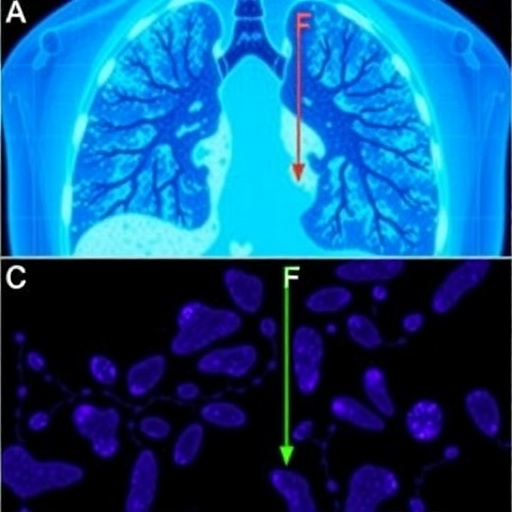
In the landscape of autoimmune diseases, rheumatoid arthritis (RA) stands as one of the most prevalent and debilitating conditions affecting millions worldwide. As researchers delve deeper into the molecular underpinnings of this complex disease, recent investigations have highlighted the potential of circular RNAs (circRNAs) as valuable biomarkers. Specifically, the study conducted by Li, Deng, and Wang has brought to light two particular circRNAs—circRNA_0001412 and circRNA_0001566—that may pave the way for innovative diagnostic approaches in rheumatology.
The significance of early diagnosis in rheumatoid arthritis cannot be overstated. Early detection not only facilitates timely intervention but also dramatically improves patient outcomes. Traditional biomarkers for RA, such as rheumatoid factor and anti-citrullinated protein antibodies, are crucial but can lack specificity. They may lead to misdiagnosis or delayed treatment. This underlines the pressing need for more reliable and precise biomarkers, especially in the quest for individualized treatment strategies.
CircRNAs are a class of non-coding RNAs characterized by their covalently closed loop structure, which makes them resistant to exonuclease-mediated degradation. This unique structure grants circRNAs stability in various biological contexts. Moreover, circRNAs are involved in various cellular processes, including gene regulation, splicing, and even playing roles in the development of various diseases. As a consequence, they have emerged as promising candidates for biomarker development.
The research team set out to investigate the expression levels of circRNA_0001412 and circRNA_0001566 in patients diagnosed with rheumatoid arthritis compared to healthy controls. Utilizing state-of-the-art sequencing techniques, the investigators meticulously analyzed blood samples from multiple cohorts to ensure a comprehensive understanding of these circRNAs’ roles in RA. This methodical approach enabled them to draw robust conclusions regarding the potential diagnostic utility of these biomarkers.
What makes circRNA_0001412 and circRNA_0001566 particularly compelling is their differential expression in patients with RA. The study found that levels of these circRNAs were significantly altered in rheumatoid arthritis patients, indicating potential contributions to the pathophysiology of the disease. Elevated levels of these circRNAs may reflect the underlying inflammatory environment typical of RA pathology, suggesting they could serve as indicators of disease activity.
Moreover, the implications of these findings extend beyond diagnosis. CircRNAs hold potential not only as biomarkers but also as therapeutic targets. Understanding the mechanisms through which circRNA_0001412 and circRNA_0001566 exert their effects may open new avenues for treatment. Targeting these circRNAs, either to modulate their expression or to disrupt their function, could emerge as an innovative approach in managing rheumatoid arthritis.
The researchers also conducted a rigorous analysis of the mechanisms by which circRNA_0001412 and circRNA_0001566 influence cellular pathways connected to inflammation and immune regulation. By delving into the intricate interactions between these circRNAs and their target molecules, they uncovered a network of regulatory pathways that may elucidate their roles in the chronic inflammation characteristic of RA. This understanding can inform future therapeutic strategies targeting these pathways.
Furthermore, the study emphasizes the importance of integrating circRNA profiling into the clinical setting. By assessing circRNA levels in serum or plasma samples, clinicians could potentially leverage these biomarkers to refine diagnosis and monitor disease progression. Such advancements would not only facilitate personalized treatment plans but also contribute to better management of rheumatoid arthritis, enhancing the quality of life for many patients.
The research also sets the stage for future studies aimed at validating these findings in larger, more diverse populations. While the current results are promising, extensive validation is essential to establish the reliability and practicality of circRNA_0001412 and circRNA_0001566 as diagnostic biomarkers. Future work will undoubtedly focus on longitudinal studies that assess how changes in circRNA levels correspond with clinical outcomes.
Another critical aspect of this research revolves around the potential for circRNAs to be used in combination with existing biomarkers. A multi-biomarker panel that includes circRNA_0001412 and circRNA_0001566 could enhance diagnostic accuracy significantly. Combining these molecular markers could yield a more comprehensive view of the patient’s disease status, allowing for better-informed decisions regarding treatment options.
In the ever-evolving field of rheumatology, the exploration of circRNAs signifies a promising avenue to advance our understanding and management of autoimmune diseases. As researchers continue to unlock the mysteries of these versatile molecules, the hope remains that innovations in this arena will translate into tangible benefits for patients battling rheumatoid arthritis and other inflammatory conditions.
In conclusion, the groundbreaking work by Li, Deng, and Wang highlights circRNA_0001412 and circRNA_0001566 as potential game-changers in the diagnosis and treatment of rheumatoid arthritis. With their unique structural properties and regulatory roles, these circRNAs not only present new opportunities for early detection but also mark a step towards personalized medicine in rheumatology. This study underscores the importance of continued research into circRNAs, as we strive to enhance our diagnostic capabilities and ultimately improve patient outcomes in autoimmune diseases.
Subject of Research: Circular RNAs as biomarkers in rheumatoid arthritis
Article Title: CircRNA_0001412 and CircRNA_0001566 as Potential Biomarkers for the Diagnosis of Rheumatoid Arthritis
Article References:
Li, X., Deng, A., Wang, Z. et al. CircRNA_0001412 and CircRNA_0001566 as Potential Biomarkers for the Diagnosis of Rheumatoid Arthritis.
Biochem Genet (2025). https://doi.org/10.1007/s10528-025-11219-8
Image Credits: AI Generated
DOI:
Keywords: CircRNA, rheumatoid arthritis, biomarkers, diagnosis, personalized medicine, autoimmune diseases, molecular biology
Tags: challenges in traditional RA biomarkerscircRNA_0001412 significancecircRNA_0001566 research findingscircular RNAs in autoimmune diseasesearly diagnosis of rheumatoid arthritisgene regulation by circRNAsindividual treatment strategies for rheumatoid arthritisinnovative diagnostic approaches for RAnon-coding RNAs in rheumatologyprecision medicine in autoimmune diseasesrheumatoid arthritis biomarkersstability of circular RNAs




